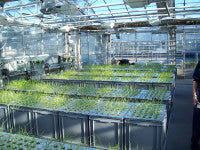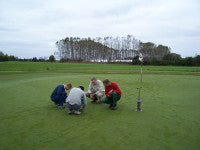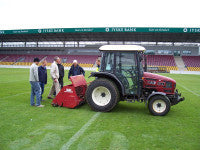Competition Winners see Innovation in Grass Breeding
 Recent winners of the BTME competition run by DLF Trifolium and Pitchcare were given an excellent opportunity to see recent developments in grass breeding at parent company in Denmark.
Recent winners of the BTME competition run by DLF Trifolium and Pitchcare were given an excellent opportunity to see recent developments in grass breeding at parent company in Denmark.
Day 1
The two winners, Colin Ashman and Nick Hargreaves, together with Paul Hadley, Amenity Sales DLF UK were met by Mogens Toft Jensen - DLF Group Marketing and Product Development Manager, the guide for the this October.
The first day was spent at the DLF plant breeding station just outside Copenhagan. Part of the laboratory tour included an insight into the gene mapping work taking place which helps breeders identify desirable characteristics required. This can range from high sugar content for agricultural grasses through to natural drought stress for amenity grass types.
Early on, discoveries can help speed up the breeding process. Of particular interest was the new hydroponics glasshouse which allows DLF to test grasses species by species for specific traits or tolerances. For example, the current trial is on salt tolerance of ryegrass. The liquid in the hydroponics system can have any chemical element added to it, thus natural tolerances and resistance can be assessed giving DLF breeders and customers alike proven information about specific cultivars.
which allows DLF to test grasses species by species for specific traits or tolerances. For example, the current trial is on salt tolerance of ryegrass. The liquid in the hydroponics system can have any chemical element added to it, thus natural tolerances and resistance can be assessed giving DLF breeders and customers alike proven information about specific cultivars.
The breeders trials and demonstration plots were of great interest, giving a real insight into the new cultivars soon available from the various breeding programmes run by DLF. Here you can see the results of all the work that goes on in the earlier stages of the breeding process.
Different nutrient regimes were also in trial. In Denmark, restrictions are much tighter than in UK with regard to chemical and fertiliser application, therefore producing grasses with a lower nutrient requirement or resistance to specific diseases are key goals of the breeding programmes.
Cont…
The questions and conversation continued into the early evening, as the length of shadows in the picture indicates.
 Day 2
Day 2
The first visit of the day was to a DLF seed processing plant at Benlose, to see a Poa pratensis crop going through the cleaning machines, following the process from start to finish. Colin and Nick both commented on how involved the seed cleaning process was and how big a difference there was between the harvested material and the cleaned certified seed that goes into the bag to be sold. Although time consuming it is essential that the cleaning process is as thorough as it is, to guarantee the quality of the finished product.
Whilst at Benlose it was possible to see a new innovation in seed sampling. DLF are currently working on a new Automated Seed Purity Scanner. Rather than a seed sample being analysed by hand, which is a very lengthy process as every seed in the sample has to be identified in order to work out the purity, the scanner has a database of all the different seed types from which it is able to identify the composition of the sample. This process helps to produce a high quality seed as cost effectively as possible, ultimately saving the customer money.
The second visit of the day was to the Smorum Golf Center, a course that gets a lot of Pay & Play customers, in fact one of the highest number of rounds played in Denmark. This course is managed as sustainably as possible using the very minimum of fertiliser and pesticides.
Head Greenkeeper, Per Rasmussen was keen to show off the greens, which are nearly 100% fescue and receive only 30kg of nitrogen per year, with regular top dressing using a sand/compost mix.
Per is keen to stress that he has kept the same top dressing blend for many years which has produced a very consistent root zone. Very little disturbance of the surface takes place with regard to aeration or scarification, which suits the fescues perfectly.
Smorum greens are living proof that given the right management, coupled with top cultivars such as Cezanne and Musica, top results can be achieved even in a high wear situation.
The day was completed with a visit to Farum Stadium north of Copenhagan. Unusually this was an old pitch surrounded by a new stadium, making it quite a challenge for the grounds team. On the day of the visit the team were carrying out their last overseeding programme of the year. The stadium's regular overseeding mixture is based around the UKs No 1 winter sport perennial ryegrass, Bizet. Due to the variability of the soil profile, regular drainage, aeration and overseeding work is undertaken to keep the surface playable.

At the end of two very busy days we agreed the trip had been a real eye opener. Both Nick and Colin were surprised by the effort and complexity of the breeding and production process necessary to deliver a guaranteed product to market.
Everyone was impressed by the results achieved by Pere at the Smorum Golf Center, who, by adopting a different management approach to his greens and keeping faith with his maintenance regime, has produced a truly sustainable fescue sward. Thanks go to Mogens for his time and commentary during our visit.
For further information about the range of Amenity mixtures from DLF Trifolium please contact 01386 791102, Email:amenity@dlf.co.uk or visit the Website: www.dlf.co.uk/
